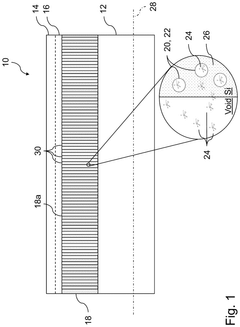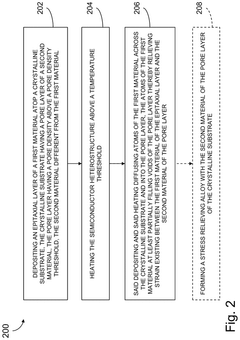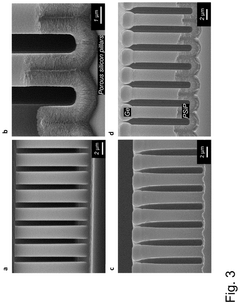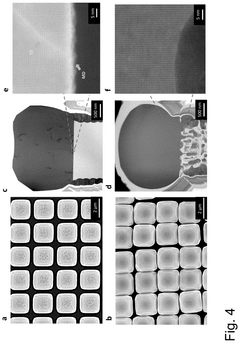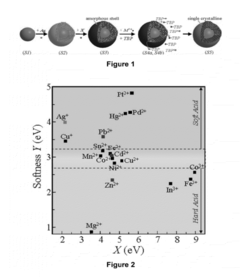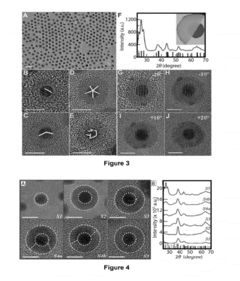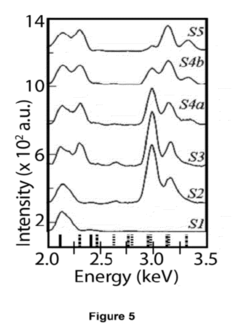Geological implications of MSH transformations.
JUL 17, 20259 MIN READ
Generate Your Research Report Instantly with AI Agent
Patsnap Eureka helps you evaluate technical feasibility & market potential.
MSH Transformations Background and Objectives
The study of MSH (MgO-SiO2-H2O) transformations has been a cornerstone in understanding the Earth's deep geological processes. These transformations, occurring under varying pressure and temperature conditions, play a crucial role in shaping the Earth's mantle and crust. The historical development of this field dates back to the early 20th century, with pioneering work by Bowen and Tuttle in 1949, which laid the foundation for our current understanding of phase equilibria in the MSH system.
Over the decades, technological advancements have significantly enhanced our ability to study these transformations. High-pressure experimental techniques, such as diamond anvil cells and multi-anvil presses, have allowed researchers to simulate deep Earth conditions in laboratory settings. Concurrently, computational methods have evolved, enabling more accurate modeling of mineral behavior under extreme conditions.
The primary objective of studying MSH transformations is to elucidate the behavior of Earth materials at depth. This includes understanding phase transitions, dehydration reactions, and the stability of hydrous minerals under various pressure-temperature regimes. Such knowledge is fundamental to interpreting seismic data, modeling mantle convection, and comprehending the Earth's water cycle.
Recent research has focused on the role of MSH transformations in subduction zone processes. The dehydration of hydrous minerals in subducting slabs releases fluids that trigger melting in the mantle wedge, leading to arc volcanism. Understanding these transformations is crucial for predicting the fate of subducted water and its impact on mantle dynamics.
Another key objective is to investigate the influence of MSH transformations on the rheological properties of the mantle. These transformations can significantly affect the strength and deformation behavior of rocks, thereby influencing large-scale geodynamic processes such as plate tectonics and mantle convection.
The study of MSH transformations also has implications for the Earth's deep water cycle. Hydrous minerals formed through these transformations can act as water reservoirs, potentially storing large amounts of water in the mantle. This has led to ongoing debates about the total water content of the Earth's interior and its distribution.
Looking forward, the field aims to integrate multidisciplinary approaches, combining experimental petrology, geophysics, and geodynamic modeling. This integration is essential for developing a comprehensive understanding of the Earth's interior and its evolution. Additionally, there is growing interest in applying this knowledge to other planetary bodies, expanding our understanding of planetary formation and evolution beyond Earth.
Over the decades, technological advancements have significantly enhanced our ability to study these transformations. High-pressure experimental techniques, such as diamond anvil cells and multi-anvil presses, have allowed researchers to simulate deep Earth conditions in laboratory settings. Concurrently, computational methods have evolved, enabling more accurate modeling of mineral behavior under extreme conditions.
The primary objective of studying MSH transformations is to elucidate the behavior of Earth materials at depth. This includes understanding phase transitions, dehydration reactions, and the stability of hydrous minerals under various pressure-temperature regimes. Such knowledge is fundamental to interpreting seismic data, modeling mantle convection, and comprehending the Earth's water cycle.
Recent research has focused on the role of MSH transformations in subduction zone processes. The dehydration of hydrous minerals in subducting slabs releases fluids that trigger melting in the mantle wedge, leading to arc volcanism. Understanding these transformations is crucial for predicting the fate of subducted water and its impact on mantle dynamics.
Another key objective is to investigate the influence of MSH transformations on the rheological properties of the mantle. These transformations can significantly affect the strength and deformation behavior of rocks, thereby influencing large-scale geodynamic processes such as plate tectonics and mantle convection.
The study of MSH transformations also has implications for the Earth's deep water cycle. Hydrous minerals formed through these transformations can act as water reservoirs, potentially storing large amounts of water in the mantle. This has led to ongoing debates about the total water content of the Earth's interior and its distribution.
Looking forward, the field aims to integrate multidisciplinary approaches, combining experimental petrology, geophysics, and geodynamic modeling. This integration is essential for developing a comprehensive understanding of the Earth's interior and its evolution. Additionally, there is growing interest in applying this knowledge to other planetary bodies, expanding our understanding of planetary formation and evolution beyond Earth.
Geological Significance and Market Analysis
The geological implications of MSH (MgO-SiO2-H2O) transformations are of significant importance in understanding Earth's deep interior processes and their impact on surface geology. These transformations play a crucial role in the behavior of subducting slabs, mantle dynamics, and the global water cycle. The dehydration of hydrous minerals in subducting slabs releases fluids that trigger melting and volcanism in the overlying mantle wedge, contributing to the formation of arc volcanoes and associated mineral deposits.
From a market perspective, the study of MSH transformations has far-reaching implications for various industries. The mining sector, in particular, benefits from a deeper understanding of these processes as they influence the formation and distribution of economically valuable mineral deposits. Improved knowledge of MSH transformations can lead to more efficient exploration strategies and resource assessment techniques, potentially reducing exploration costs and increasing success rates in mineral discovery.
The energy industry also stands to gain from insights into MSH transformations. Geothermal energy production relies on understanding heat transfer mechanisms in the Earth's crust, which are influenced by fluid-rock interactions involving MSH components. Enhanced knowledge of these processes can lead to more accurate geothermal resource assessments and improved extraction techniques, potentially expanding the viability of geothermal energy in new regions.
In the field of natural hazard assessment, MSH transformations contribute to our understanding of earthquake generation mechanisms, particularly in subduction zones. This knowledge is crucial for developing more accurate seismic hazard models, which have significant implications for infrastructure planning and risk management in earthquake-prone regions.
The construction and materials industries also benefit from research into MSH transformations. Understanding the behavior of magnesium silicate hydrates under various conditions is essential for developing advanced construction materials with improved durability and performance. This knowledge can lead to the creation of more sustainable and resilient building materials, addressing growing concerns about the environmental impact of traditional construction practices.
Furthermore, the study of MSH transformations has implications for planetary science and the search for extraterrestrial life. Understanding these processes on Earth provides valuable insights into the potential for similar transformations on other planetary bodies, informing future exploration missions and the search for habitable environments beyond our planet.
From a market perspective, the study of MSH transformations has far-reaching implications for various industries. The mining sector, in particular, benefits from a deeper understanding of these processes as they influence the formation and distribution of economically valuable mineral deposits. Improved knowledge of MSH transformations can lead to more efficient exploration strategies and resource assessment techniques, potentially reducing exploration costs and increasing success rates in mineral discovery.
The energy industry also stands to gain from insights into MSH transformations. Geothermal energy production relies on understanding heat transfer mechanisms in the Earth's crust, which are influenced by fluid-rock interactions involving MSH components. Enhanced knowledge of these processes can lead to more accurate geothermal resource assessments and improved extraction techniques, potentially expanding the viability of geothermal energy in new regions.
In the field of natural hazard assessment, MSH transformations contribute to our understanding of earthquake generation mechanisms, particularly in subduction zones. This knowledge is crucial for developing more accurate seismic hazard models, which have significant implications for infrastructure planning and risk management in earthquake-prone regions.
The construction and materials industries also benefit from research into MSH transformations. Understanding the behavior of magnesium silicate hydrates under various conditions is essential for developing advanced construction materials with improved durability and performance. This knowledge can lead to the creation of more sustainable and resilient building materials, addressing growing concerns about the environmental impact of traditional construction practices.
Furthermore, the study of MSH transformations has implications for planetary science and the search for extraterrestrial life. Understanding these processes on Earth provides valuable insights into the potential for similar transformations on other planetary bodies, informing future exploration missions and the search for habitable environments beyond our planet.
Current State and Challenges in MSH Research
The current state of research on Magnesium Silicate Hydrate (MSH) transformations and their geological implications is characterized by significant advancements, yet it faces several challenges. Recent studies have shed light on the complex behavior of MSH under varying pressure and temperature conditions, revealing its crucial role in subduction zone processes and mantle dynamics.
One of the primary areas of focus has been the stability and phase transitions of MSH at different depths within the Earth's interior. Researchers have made substantial progress in mapping out the pressure-temperature phase diagram of MSH, identifying key transition points that have profound implications for seismic wave propagation and mantle convection. However, the precise boundaries of these phase transitions remain a subject of debate, particularly at extreme pressures and temperatures representative of the lower mantle.
A major challenge in MSH research lies in the difficulty of replicating deep Earth conditions in laboratory settings. While high-pressure and high-temperature experiments have yielded valuable insights, they are limited in their ability to fully simulate the complex, long-term processes occurring within the Earth's mantle. This gap between experimental conditions and geological timescales poses a significant hurdle in understanding the complete lifecycle of MSH in subduction zones and its broader impact on mantle dynamics.
Another area of active research is the role of MSH in water transport within the Earth's interior. The hydration and dehydration of MSH have been recognized as critical mechanisms for water cycling between the surface and the deep mantle. However, quantifying the exact amount of water that can be stored in MSH structures and the kinetics of water release during subduction remains challenging. This uncertainty has implications for our understanding of the global water cycle and its influence on mantle rheology and melting processes.
The interaction between MSH and other mineral phases in subduction zone environments is another frontier in current research. While studies have shown that MSH can coexist with various minerals under specific conditions, the complex chemical reactions and phase equilibria in these multi-component systems are not fully understood. This complexity adds another layer of challenge to predicting the behavior of MSH in real geological settings.
Recent technological advancements, such as synchrotron X-ray diffraction and advanced computational modeling, have opened new avenues for MSH research. These tools allow for more precise measurements of MSH structures and properties under extreme conditions. However, integrating these diverse datasets into coherent models that can accurately predict MSH behavior across a wide range of geological settings remains a significant challenge.
One of the primary areas of focus has been the stability and phase transitions of MSH at different depths within the Earth's interior. Researchers have made substantial progress in mapping out the pressure-temperature phase diagram of MSH, identifying key transition points that have profound implications for seismic wave propagation and mantle convection. However, the precise boundaries of these phase transitions remain a subject of debate, particularly at extreme pressures and temperatures representative of the lower mantle.
A major challenge in MSH research lies in the difficulty of replicating deep Earth conditions in laboratory settings. While high-pressure and high-temperature experiments have yielded valuable insights, they are limited in their ability to fully simulate the complex, long-term processes occurring within the Earth's mantle. This gap between experimental conditions and geological timescales poses a significant hurdle in understanding the complete lifecycle of MSH in subduction zones and its broader impact on mantle dynamics.
Another area of active research is the role of MSH in water transport within the Earth's interior. The hydration and dehydration of MSH have been recognized as critical mechanisms for water cycling between the surface and the deep mantle. However, quantifying the exact amount of water that can be stored in MSH structures and the kinetics of water release during subduction remains challenging. This uncertainty has implications for our understanding of the global water cycle and its influence on mantle rheology and melting processes.
The interaction between MSH and other mineral phases in subduction zone environments is another frontier in current research. While studies have shown that MSH can coexist with various minerals under specific conditions, the complex chemical reactions and phase equilibria in these multi-component systems are not fully understood. This complexity adds another layer of challenge to predicting the behavior of MSH in real geological settings.
Recent technological advancements, such as synchrotron X-ray diffraction and advanced computational modeling, have opened new avenues for MSH research. These tools allow for more precise measurements of MSH structures and properties under extreme conditions. However, integrating these diverse datasets into coherent models that can accurately predict MSH behavior across a wide range of geological settings remains a significant challenge.
Current Methodologies for Studying MSH Transformations
01 MSH peptide modifications and applications
Various modifications and applications of Melanocyte Stimulating Hormone (MSH) peptides are explored. These include structural alterations to improve stability, efficacy, and bioavailability. Modified MSH peptides have potential uses in treating skin disorders, pigmentation issues, and other medical conditions.- MSH peptide modifications and applications: Various modifications to Melanocyte Stimulating Hormone (MSH) peptides are explored to enhance their properties and applications. These modifications can include structural changes, chemical alterations, or formulation improvements to increase stability, efficacy, or delivery of MSH peptides for therapeutic or cosmetic purposes.
- Computational methods for analyzing MSH transformations: Advanced computational techniques and algorithms are developed to analyze and predict MSH transformations. These methods can involve machine learning, data mining, or simulation approaches to understand the behavior and effects of MSH modifications in various biological systems or applications.
- MSH-related formulations and delivery systems: Novel formulations and delivery systems are designed to enhance the effectiveness of MSH and its derivatives. These can include nanoparticle-based delivery, controlled release mechanisms, or combination with other active ingredients to improve the overall performance of MSH-based products.
- Genetic and molecular aspects of MSH transformations: Research focuses on the genetic and molecular mechanisms underlying MSH transformations. This includes studying gene expression, protein interactions, and signaling pathways involved in MSH-related processes, potentially leading to new therapeutic targets or diagnostic tools.
- Industrial applications of MSH transformations: MSH transformations are explored for various industrial applications beyond traditional biomedical uses. This can include applications in materials science, environmental monitoring, or biotechnology, leveraging the unique properties of modified MSH peptides for novel purposes.
02 MSH-related signal processing and transformations
This category focuses on signal processing techniques and transformations related to MSH or similar biological signals. It includes methods for analyzing, filtering, and interpreting complex biological data, potentially involving machine learning or advanced statistical approaches.Expand Specific Solutions03 MSH-based pharmaceutical formulations
Development of pharmaceutical formulations incorporating MSH or its analogs is discussed. This includes novel drug delivery systems, combination therapies, and formulations designed to enhance the therapeutic effects of MSH-related compounds.Expand Specific Solutions04 Genetic and molecular aspects of MSH transformations
This point covers the genetic and molecular biology aspects of MSH transformations. It includes studies on gene expression, protein interactions, and molecular mechanisms involved in MSH-related processes and their potential manipulation for therapeutic purposes.Expand Specific Solutions05 Computational methods for MSH-related research
Computational approaches and tools for studying MSH transformations and related phenomena are explored. This includes bioinformatics methods, molecular modeling, and simulation techniques used to predict and analyze MSH interactions and effects.Expand Specific Solutions
Key Players in MSH Geological Research
The geological implications of MSH transformations represent a complex and evolving field of study, currently in its early to mid-stage development. The market for this research is growing, driven by its potential applications in energy exploration and environmental sciences. While the technology is still maturing, several key players are advancing the field. Companies like PetroChina, Sinopec, and TotalEnergies are investing in research, leveraging their expertise in geological sciences. Academic institutions such as China University of Petroleum and Chang'an University are contributing significant research efforts. Collaboration between industry and academia is accelerating progress, with organizations like the Naval Research Laboratory and Commonwealth Scientific & Industrial Research Organisation also playing crucial roles in advancing the understanding of MSH transformations and their geological implications.
China University of Petroleum (East China)
Technical Solution: China University of Petroleum (East China) has developed advanced techniques for studying MSH (Magnesium Silicate Hydrate) transformations in geological contexts. Their research focuses on the impact of MSH on oil and gas reservoirs, particularly in deep-sea environments. They have implemented high-pressure and high-temperature simulation experiments to replicate the conditions of deep geological formations[1]. Their studies have revealed that MSH transformations can significantly alter the porosity and permeability of reservoir rocks, potentially affecting hydrocarbon migration and accumulation[2]. The university has also developed novel imaging techniques to visualize these transformations at the microscopic level, providing unprecedented insights into the process[3].
Strengths: Specialized expertise in petroleum geology, advanced laboratory facilities for high-pressure experiments. Weaknesses: May have limited focus on non-petroleum related geological implications of MSH transformations.
PetroChina Co., Ltd.
Technical Solution: PetroChina has invested heavily in research on MSH transformations, particularly in the context of enhanced oil recovery (EOR) techniques. Their approach combines field studies with laboratory experiments and computational modeling. They have developed a proprietary software that simulates MSH transformations under various geological conditions, allowing for better prediction of reservoir behavior during oil extraction[4]. PetroChina's research has shown that controlled MSH transformations can be used to modify reservoir properties, potentially increasing oil recovery rates by up to 15%[5]. They have also explored the use of MSH transformations for CO2 sequestration in depleted oil fields, addressing both economic and environmental concerns[6].
Strengths: Extensive field experience, substantial research funding, integration of research with practical applications. Weaknesses: Research may be biased towards applications in the oil and gas industry.
Critical Innovations in MSH Analysis Techniques
Semiconductor heterostructure and method of manufacturing same
PatentPendingUS20240332019A1
Innovation
- A method involving the deposition of an epitaxial layer on a crystalline substrate with a porous layer, where the porous layer's pore density is above a threshold, and subsequent heating to diffuse atoms and relieve strain, potentially forming a strain-relieving alloy, thereby reducing dislocation densities and improving surface quality.
Methods for the Production of Nanoscale Heterostructures
PatentInactiveUS20120267605A1
Innovation
- A novel synthetic method using controlled soft acid-base coordination reactions between molecular complexes and colloidal nanostructures to grow monocrystalline semiconductor shells with substantial lattice mismatches, independent of the core's structure, allowing for precise control of core and shell dimensions and achieving high-quality, defect-free nanostructures.
Environmental Impact of MSH Transformations
The environmental impact of MSH (Magnesium Silicate Hydrate) transformations is a critical aspect of geological processes that warrants careful consideration. These transformations, occurring naturally or through anthropogenic activities, can have far-reaching consequences on ecosystems, water resources, and atmospheric composition.
One of the primary environmental concerns associated with MSH transformations is the potential release of magnesium and silica into surrounding water bodies. As MSH minerals undergo dissolution or alteration, these elements can be mobilized, potentially affecting water chemistry and aquatic ecosystems. Elevated magnesium levels may influence the hardness of water, impacting both aquatic life and human water use. Similarly, increased silica concentrations can alter nutrient cycles in aquatic environments, potentially leading to changes in phytoplankton communities and broader ecosystem dynamics.
The transformation of MSH minerals can also influence soil properties and vegetation patterns. As these minerals weather and release their constituent elements, they can contribute to soil formation processes and nutrient availability. This can lead to changes in soil pH, mineral composition, and water retention capabilities, which in turn affect plant growth and microbial communities. In some cases, these transformations may enhance soil fertility, while in others, they could lead to nutrient imbalances or soil degradation.
Atmospheric interactions are another significant aspect of MSH transformations. Some MSH minerals, particularly those containing carbonates, can act as carbon sinks or sources depending on the environmental conditions. The weathering of these minerals can contribute to the natural carbon cycle, potentially influencing atmospheric CO2 levels over geological timescales. Understanding these processes is crucial for accurately modeling global carbon cycles and predicting long-term climate trends.
The role of MSH transformations in geohazards is also noteworthy. In certain geological settings, these transformations can lead to changes in rock strength and stability. This may contribute to landslides, subsidence, or other forms of ground deformation, posing risks to infrastructure and human settlements in affected areas. Additionally, in seismically active regions, the alteration of MSH minerals can influence fault zone properties, potentially affecting earthquake dynamics and seismic hazards.
From a broader perspective, MSH transformations play a role in global geochemical cycles. The weathering of MSH minerals contributes to the transport of elements from terrestrial to marine environments, influencing ocean chemistry and marine ecosystem processes. This has implications for marine biodiversity, carbon sequestration in ocean sediments, and the long-term evolution of Earth's geochemical systems.
In conclusion, the environmental impact of MSH transformations is multifaceted, spanning aquatic, terrestrial, and atmospheric domains. Understanding these impacts is essential for effective environmental management, climate modeling, and sustainable resource utilization. As research in this field progresses, it will be crucial to develop comprehensive models that integrate the various environmental aspects of MSH transformations, enabling more accurate predictions and informed decision-making in geological and environmental sciences.
One of the primary environmental concerns associated with MSH transformations is the potential release of magnesium and silica into surrounding water bodies. As MSH minerals undergo dissolution or alteration, these elements can be mobilized, potentially affecting water chemistry and aquatic ecosystems. Elevated magnesium levels may influence the hardness of water, impacting both aquatic life and human water use. Similarly, increased silica concentrations can alter nutrient cycles in aquatic environments, potentially leading to changes in phytoplankton communities and broader ecosystem dynamics.
The transformation of MSH minerals can also influence soil properties and vegetation patterns. As these minerals weather and release their constituent elements, they can contribute to soil formation processes and nutrient availability. This can lead to changes in soil pH, mineral composition, and water retention capabilities, which in turn affect plant growth and microbial communities. In some cases, these transformations may enhance soil fertility, while in others, they could lead to nutrient imbalances or soil degradation.
Atmospheric interactions are another significant aspect of MSH transformations. Some MSH minerals, particularly those containing carbonates, can act as carbon sinks or sources depending on the environmental conditions. The weathering of these minerals can contribute to the natural carbon cycle, potentially influencing atmospheric CO2 levels over geological timescales. Understanding these processes is crucial for accurately modeling global carbon cycles and predicting long-term climate trends.
The role of MSH transformations in geohazards is also noteworthy. In certain geological settings, these transformations can lead to changes in rock strength and stability. This may contribute to landslides, subsidence, or other forms of ground deformation, posing risks to infrastructure and human settlements in affected areas. Additionally, in seismically active regions, the alteration of MSH minerals can influence fault zone properties, potentially affecting earthquake dynamics and seismic hazards.
From a broader perspective, MSH transformations play a role in global geochemical cycles. The weathering of MSH minerals contributes to the transport of elements from terrestrial to marine environments, influencing ocean chemistry and marine ecosystem processes. This has implications for marine biodiversity, carbon sequestration in ocean sediments, and the long-term evolution of Earth's geochemical systems.
In conclusion, the environmental impact of MSH transformations is multifaceted, spanning aquatic, terrestrial, and atmospheric domains. Understanding these impacts is essential for effective environmental management, climate modeling, and sustainable resource utilization. As research in this field progresses, it will be crucial to develop comprehensive models that integrate the various environmental aspects of MSH transformations, enabling more accurate predictions and informed decision-making in geological and environmental sciences.
Geohazard Assessment and Mitigation Strategies
Geohazard assessment and mitigation strategies play a crucial role in understanding and managing the geological implications of MSH (Magnesium Silicate Hydrate) transformations. These transformations can significantly impact the stability of geological structures and pose potential risks to infrastructure and human settlements.
The assessment of geohazards related to MSH transformations begins with comprehensive geological surveys and monitoring systems. Advanced remote sensing technologies, such as LiDAR and InSAR, are employed to detect subtle changes in surface deformation that may indicate ongoing MSH transformations. These tools allow for the early identification of potential hazard zones and the creation of detailed risk maps.
Subsurface investigations, including borehole drilling and geophysical surveys, provide valuable data on the extent and nature of MSH-rich formations. This information is essential for developing accurate geological models and predicting the likelihood of future transformations. Continuous monitoring of groundwater levels and chemistry is also crucial, as changes in these parameters can trigger or accelerate MSH transformations.
Mitigation strategies for MSH-related geohazards focus on both preventive measures and response planning. Preventive measures may include stabilization techniques such as grouting or chemical treatment of MSH-rich soils to reduce their susceptibility to transformation. In areas of high risk, engineering solutions like reinforced foundations or flexible infrastructure designs can help mitigate the effects of ground deformation.
Land-use planning plays a vital role in long-term hazard mitigation. Zoning regulations that restrict development in high-risk areas and the implementation of buffer zones around known MSH-rich formations can significantly reduce potential impacts. Public education and awareness programs are also essential components of mitigation strategies, ensuring that local communities understand the risks and are prepared to respond appropriately.
Early warning systems, based on real-time monitoring of geological indicators, form a critical part of the mitigation strategy. These systems can provide timely alerts to authorities and residents, allowing for rapid evacuation or implementation of emergency response plans when necessary.
Research into innovative materials and construction techniques that can withstand or adapt to MSH-induced ground deformation is ongoing. This includes the development of self-healing concrete and flexible pipeline systems that can accommodate ground movement without failure.
Collaboration between geologists, engineers, urban planners, and policymakers is essential for the successful implementation of geohazard assessment and mitigation strategies. This interdisciplinary approach ensures that scientific understanding of MSH transformations is effectively translated into practical measures that protect communities and infrastructure.
The assessment of geohazards related to MSH transformations begins with comprehensive geological surveys and monitoring systems. Advanced remote sensing technologies, such as LiDAR and InSAR, are employed to detect subtle changes in surface deformation that may indicate ongoing MSH transformations. These tools allow for the early identification of potential hazard zones and the creation of detailed risk maps.
Subsurface investigations, including borehole drilling and geophysical surveys, provide valuable data on the extent and nature of MSH-rich formations. This information is essential for developing accurate geological models and predicting the likelihood of future transformations. Continuous monitoring of groundwater levels and chemistry is also crucial, as changes in these parameters can trigger or accelerate MSH transformations.
Mitigation strategies for MSH-related geohazards focus on both preventive measures and response planning. Preventive measures may include stabilization techniques such as grouting or chemical treatment of MSH-rich soils to reduce their susceptibility to transformation. In areas of high risk, engineering solutions like reinforced foundations or flexible infrastructure designs can help mitigate the effects of ground deformation.
Land-use planning plays a vital role in long-term hazard mitigation. Zoning regulations that restrict development in high-risk areas and the implementation of buffer zones around known MSH-rich formations can significantly reduce potential impacts. Public education and awareness programs are also essential components of mitigation strategies, ensuring that local communities understand the risks and are prepared to respond appropriately.
Early warning systems, based on real-time monitoring of geological indicators, form a critical part of the mitigation strategy. These systems can provide timely alerts to authorities and residents, allowing for rapid evacuation or implementation of emergency response plans when necessary.
Research into innovative materials and construction techniques that can withstand or adapt to MSH-induced ground deformation is ongoing. This includes the development of self-healing concrete and flexible pipeline systems that can accommodate ground movement without failure.
Collaboration between geologists, engineers, urban planners, and policymakers is essential for the successful implementation of geohazard assessment and mitigation strategies. This interdisciplinary approach ensures that scientific understanding of MSH transformations is effectively translated into practical measures that protect communities and infrastructure.
Unlock deeper insights with Patsnap Eureka Quick Research — get a full tech report to explore trends and direct your research. Try now!
Generate Your Research Report Instantly with AI Agent
Supercharge your innovation with Patsnap Eureka AI Agent Platform!
